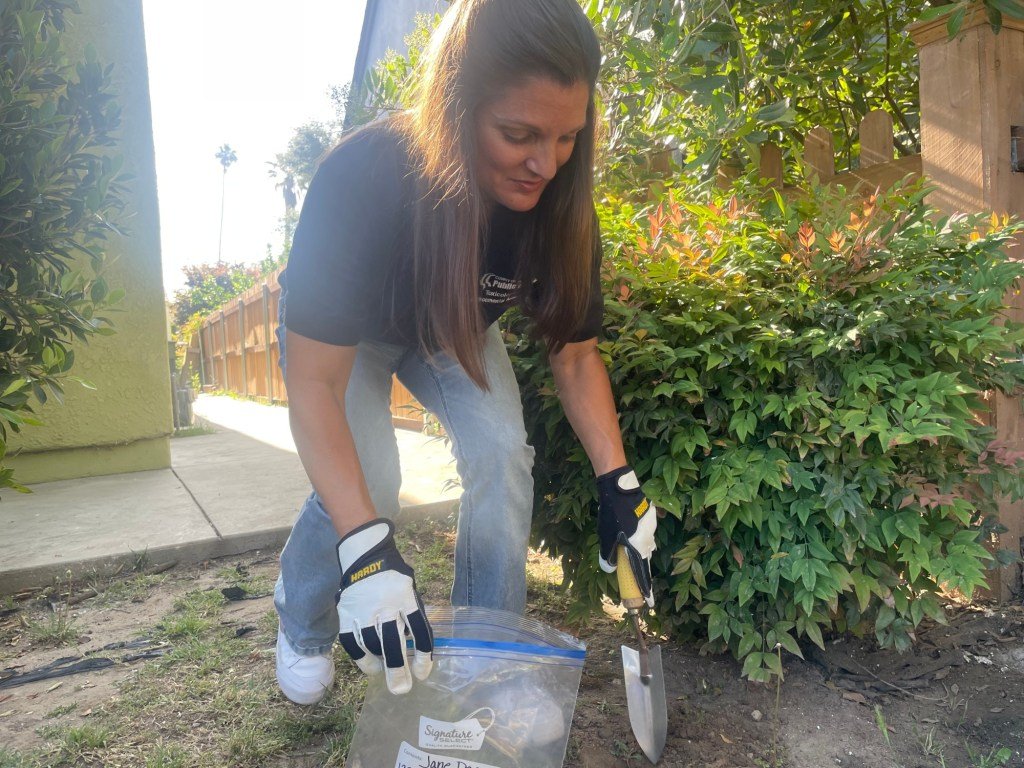Lead in the Soil: The Hidden Dangers Post-Eaton Fire
Raul Estrada stands in his front yard, surveying the verdant blend of succulents and vibrant blooms that brighten his property on the border of Pasadena and Altadena. To the untrained eye, it is a suburban oasis, nestled against the backdrop of the San Gabriel Mountains. But below this idyllic tableau lies a nerve-wracking concern: the potential presence of lead in the soil, a legacy of the devastating Eaton fire that swept through the area.
Unearthing Concerns
In the aftermath of the Eaton fire, residents like Estrada are grappling with unsettling questions about the safety of their surroundings. “I would say it’s good to know. I have kids. It’s good to know what’s going on with the soil,” Estrada remarked as he participated in the rollout of the Eaton Fire Soil Testing Program. This initiative allows homeowners to collect soil samples from their yards and submit them for lab analysis, addressing rising fears about airborne toxins.
The issue has gained urgency following the findings of the Los Angeles County Public Health Department. In April, testing revealed elevated lead levels in soil samples taken from homes in the vicinity of the fire’s burn zone. Dr. Nichole Quick, chief medical advisor for L.A. County Public Health, stated, “Lead is a neurotoxin that can have serious health implications for both children and adults.”
Pathways to Contamination
The role of environmental factors in amplifying lead exposure is underscored by research conducted by the University of Southern California. According to a recent study, “fire events can redistribute hazardous materials in neighborhoods, particularly when older structures, which often contained lead paint, are consumed by flames.” This was the case during the Eaton fire; homes built decades ago, some containing lead-based paints, ignited and dispersed harmful particles across the landscape.
- Health Risks: Lead can affect cognitive function, behavior, and development in children, while adults face risks ranging from hypertension to kidney damage.
- Soil Sampling: Estrada and others now have the option to test their property through an accessible process where residents dig and submit samples to county labs.
- Community Action: The L.A. County Public Health Department has committed $3 million to expand soil testing in affected neighborhoods.
The soil testing program seems straightforward. Residents can engage in a do-it-yourself sampling process, collecting soil from different sections of their yards and submitting it for analysis at a designated facility. The simplicity of the program belies a pressing complexity: understanding the implications of lead exposure and how to navigate the results.
A Community Mobilized
“We know that lead was a potential concern, which is why we tested for it,” said Dr. Quick, acknowledging the unexpected findings of increased lead concentrations in downwind areas. “The explanation for this impact is likely due to the burning of vintage homes, leading to the release of lead particles.”
The community has responded. With about 26,000 homes identified as potentially impacted, Public Health is proactively engaging with residents via door-to-door outreach, distributing postcards to ensure awareness of the testing opportunities. Estrada’s participation in the program exemplifies a growing movement towards communal vigilance. “It was the least I could do to offer my home for this cause,” he said, acutely aware of the shared stakes of public health.
Expert Insights
Experts are closely monitoring soil testing outcomes, recognizing this moment as a critical juncture for public health in post-fire settings. Dr. Hilda Martinez, an environmental scientist at UCLA, emphasized the significance of timely action: “Understanding lead levels in residential soil is more than just a precaution; it’s an imperative for safeguarding our children’s futures.”
Additionally, community advocates stress the importance of transparent communication about results and remediation options. “Education is key,” said Sandra Lopez, a local environmental health advocate. “We need to empower residents to take informed actions based on their soil test results.”
Tools for Understanding
The county’s website also serves as a resource, guiding residents through the interpretation of their soil test results and suggesting remedial strategies. These can vary significantly depending on lead concentrations, ranging from simple landscaping changes to more intensive soil remediation efforts.
Understanding these options is crucial. “Whether it’s putting in ground covers or completely hardscaping your yard, the right steps can make a significant difference,” Dr. Quick noted, emphasizing that proactive measures are essential in mitigating health risks.
A Lasting Impact
The memory of the Eaton fire—its flames licking the sky while dispersing toxic materials across neighborhoods—is emblazoned in Estrada’s mind. “I found ash the size of my head here, on my property,” he recalled, a stark reminder of the fire’s toll. The emotional burden is palpable as families navigate the dual threat of environmental hazards and the uncertainty that follows.
The push for soil testing in the wake of the Eaton fire is not just about immediate health concerns; it highlights a broader conversation about environmental justice. “This situation serves as a wake-up call,” Dr. Quick explained, “not just in this community, but across other neighborhoods grappling with similar issues, whether fire-related or longstanding.”
As Estrada digs into the earth of his yard, mindful of the potential dangers lurking beneath, he embodies the spirit of resilience and collective responsibility. In a community scarred by disaster, there lies the potential for renewed awareness, action, and advocacy. The soil testing program may just be the first step in not only reclaiming their yards but also in restoring peace of mind.









